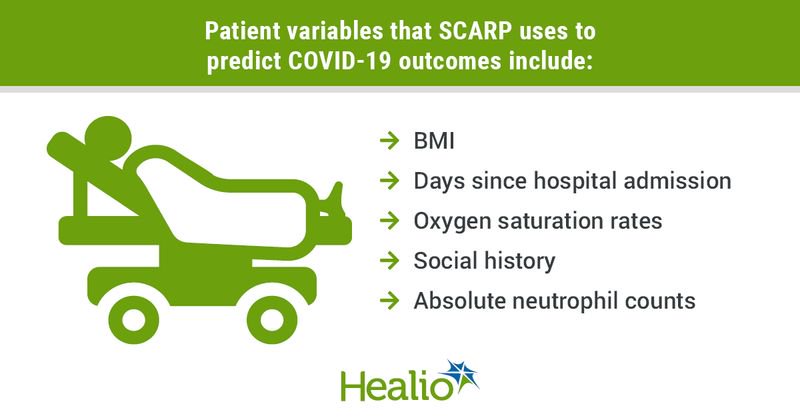Tool predicts risk for severe illness, death from COVID-19
Click Here to Manage Email Alerts
The Severe COVID-19 Adaptive Risk Predictor, or SCARP, tool showed greater than 80% accuracy in predicting a patient’s progression from moderate to severe COVID-19 disease or death within 14 days of hospitalization, researchers wrote.
SCARP has an advantage over other clinical prediction tools for SARS-CoV-2, most of which rely solely on data that are collected at the time of hospital admission, according to Matthew Robinson, MD, assistant professor of medicine at Johns Hopkins University School of Medicine and a co-author of the study.

“As patients improve or get worse, most existing tools do not have a way to update their predictions based on this new information,” he told Healio Primary Care. “Limitations of other tools in handling changing variables over time, arduous input requirements, performance caveats and uninterpretable logic inspired our efforts to create SCARP.”

SCARP is an artificial intelligence tool that “dynamically updates” as physicians enter patient variables such as BMI level; C-reactive protein, supplemental oxygen delivery, oxygen saturation and respiratory rates; days since hospital admission; admission source; social history; oxygen level and amount of supplemental oxygen needed; and absolute neutrophil and lymphocyte counts, according to the researchers. They developed the tool using a machine-learning approach known as a random forest for survival, longitudinal and multivariate data analysis.
The researchers tested SCARP during a retrospective observational study of 3,163 patients (median age, 61 years) who tested positive for SARS-CoV-2 and were admitted to a five-hospital health system between March 5, 2020, and Dec. 4, 2020. Of that cohort, 7% became severely ill or died within 24 hours of admission and another 11% became severely ill or died during the next 7 days.
Robinson and colleagues reported that the area under the receiver-operating characteristic curve (AUC) for 1-day risk predictions for progression to severe COVID-19 disease or death was 0.89 (95% CI; 0.88-0.9) during the first week of hospitalization and 0.89 (95% CI; 0.87-0.91) during the second week. The AUC for 7-day risk predictions was 0.83 (95% CI; 0.83-0.84) during the first week and 0.87 (95% CI; 0.86-0.89) during the second week of hospitalization.
According to Robinson, unlike some other tools, SCARP provides useful information in “clinically meaningful timeframes.”
“For example, if a clinician is taking care of a patient with COVID‐19 in a hospital with limited remaining critical care capacity, and SCARP shows that the patient has a low risk of developing severe disease in the next 24 hours but a high risk in the next 7 days, then they may consider transferring the patient to another facility with more access to critical care safely before the patient becomes critically ill,” he said.
He added that his research team “included ‘adaptive’ in the name of the tool because the tool sequentially asks clinicians for the next most important variable the tool needs to improve the accuracy of the prediction, which is tailored to the information already inputted.”
References:
Johns Hopkins School of Medicine. Severe COVID-19 Adaptive Risk Predictor. https://rsconnect.biostat.jhsph.edu/covid_trajectory/. Accessed March 11, 2021.
Wongvibulsin S, et al. Ann Intern Med. 2021;doi:10.7326/M20-6754.

